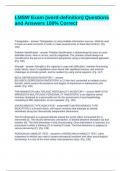LMSW Exam (word-definition) Questions
and Answers 100% Correct
Triangulation - answer Triangulation is using multiple information sources. Method used
to have accurate accounts in order to make assessments or base interventions. (Pg.
136)
Problem Identification - answer Problem identification is determining the issue in exact
definable terms, when it occurs, and its magnitude. The problem should always be
considered in the person-in-environment perspective using a strengths-based approach.
(Pg. 136)
Strength - answer Strength is the capacity to cope with difficulties, maintain functioning
under stress, return to equilibrium when faced with significant trauma, use external
challenges to promote growth, and be resilient by using social supports. (Pg. 137)
BECK DEPRESSION INVENTORY – answer
BDI (BECK DEPRESSION INVENTORY) is 21-item test, presented in multiple choice
formats, which assess the presence and degree of depression in adolescents and
adults. (Pg. 139)
THE MINNESOTA MULTIPLASIC PERSONALITY INVENTORY – answer MMPI (THE
MINNESOTA MULTIPLASIC PERSONALITY INVENTORY) is an objective verbal
inventory designed as a personality test for the assessment of psychopathology
consisting of 550 statements; 16 are repeated. (Pg. 139)
MYERS-BRIGGS TYPE INDICATOR - answerMBTI (MYERS-BRIGGS TYPE
INDICATOR) is a forced-choice, self-report inventory that attempts to classify
individuals along four theoretically independent dimensions.
The first dimension is a general attitude toward the world, either extroverted (E) or
Introverted (I). The second dimension, perception, is divided between sensation (S) and
Intuition (N). The third dimension is that of processing. Once information is recieved, it is
processed in either a thinking (T) or feeling (F) style. The final dimension is judging (J)
versus perceiving (P). (Pg. 139)
RORSCHACH INKBLOT TEST - answerIn a RORSCHACH INKBLOT TEST, client
responses to inkblots are used to assess perceptual reactions and other psychological
functioning. It is one of the most widely used projective tests. (Pg. 139)
,STANFORD-BINET INTELLIGENCE SCALE - answerThe Standford-Binet Intelligence
Scale is designed for the testing of cognitive abilities. It provides verbal, performance,
and full scale scores for children and adults. (Pg. 139)
THEMATIC APPERCEPTION TEST - answerTAT (THEMATIC APPERCEPTION
TEST) is a projective test. It consists of a series of pictures of ambiguous scenes,
Clients are asked to make up stories/fantasies concerning what is happening, has
happened, and is going to happen in the scenes, along with a description of their
thoughts and feelings. The TAT provides info on a client's perceptions and imagination
for use in the understanding of a client's current needs, motives, emotions, and
conflicts, both conscious and unconscious. (Pg. 140)
WECHSLER INTELLIGENCE SCALE - answerWISC (WECHSLER INTELLIGENCE
SCALE) is designed as a measure of a child's intellectual and cognitive ability. It has
four index scales and a full-scale score. (Pg. 140)
When storing client information, include: - answerStored client information should
include:
(1) demographic info and intake materials,
(2) assessments, quarterly reviews, and reassessments,
(3) service plan(s) with goals,
(4) a discharge plan,
(5) releases of information and referrals, and
(6) correspondence. (Pg. 140)
SOAP format (used in healthcare settings) - answerSOAP format stands for:
"Subjective" component is a client's report of how she/he has been doing since the last
visit and/or what brought a client into treatment.
"Objective" includes vital signs, documentation of any physical examinations, and
results of laboratory tests (health care setting); it can also include other objective
indicators of problems such as disorientation, failing school, legal issues, etc (other
settings).
"Assessment" is putting the subjective and objective findings together and consolidating
them into a short assessment.
"Plan" includes what will be done as a consequence of the assessment. (Pg. 141).
*Social Pragmatic Communication Disorder - answerSocial Pragmatic Communication
Disorder is having impaired social verbal and nonverbal communication. (Pg. 142).
*Autism Spectrum Disorder - answerAutism Spectrum Disorder incorporates Aspergers,
Childhood Disintegrative Disorder, and Pervasive Developmental Disorder Not
Otherwise Specified (PDD-NOS). (Pg. 142).
, *Attention-Deficit/Hyperactivity Disorder - answerAttention-Deficit/Hyperactivity Disorder
must appear by age 12. (Pg. 142).
Tic Disorders - answerA tic is an abrupt, uncontrollable movement or sound that
deviates from a person's normal gestures. For example, a person with tics may blink
rapidly and repeatedly, even if nothing is irritating their eyes.
Tic Disorders include: Tourette's disorder, persistent (chronic) motor or vocal tic
disorder, provisional tic disorder, other specified tic disorder, and unspecified tic
disorder. (Pg. 142).
Catatonia - answerCatatonia is a psychomotor disorder. It affects a person's ability to
move in a normal way. Affected people can experience a variety of symptoms. The
most common symptom is stupor, which means that the patient cannot move, speak, or
respond to stimuli. However, some catatonia sufferers may show excessive movement
and violent behavior.
Catatonia requires 3 out of 12 symtoms. Catatonis may be a specifier for Depressive,
Bipolar, and Psychotic disorders; part of another medical condition; or of another
specified diagnosis. (Pg. 143).
Disruptive Mood Dysregulation Disorder (DMDD) - answerDisruptive Mood
Dysregulation Disorder (DMDD) is a new disorder for children up to age 18 years old.
(Pg. 144) Often diagnosed in children and is characterized by frequent and severe
outbursts of anger.
Anxiety Disorder(s) duration requirement - answerAnxiety disorders must last at least 6
months (including children). (Pg. 144).
Excoriation - answerExcoriation is a skin picking disorder (new). (Pg. 145).
Trichotillomania - answerTrichotillomania is a hair-pulling disorder. (Pg. 145).
*Dissociative Identity Disorder (formally Multiple Personality Disorder) - answerDID is a
condition wherein a person's identity is fragmented into two or more distinct personality
states. People with this rare condition are often victims of severe abuse. The person
also experiences memory loss/frequent gaps in memories related to personal history,
including people, places, and events, for both the distant and recent past. (Pg. 146;
psychologytoday).
*Somatic Symptom Disorder - answerSomatic symptom disorder involves having a
significant focus on physical symptoms — such as pain or fatigue — to the point that it
causes major emotional distress and problems functioning. Pain is the most common
symptom, but whatever your symptoms, you have excessive thoughts, feelings or




